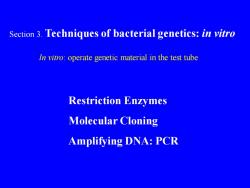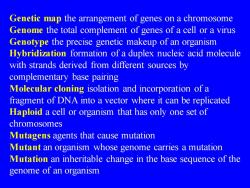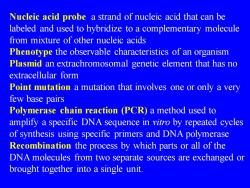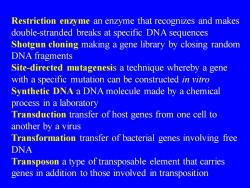华中农业大学:《食品微生物学》课程PPT教学课件(Food Microorganism)Chapter 8 Bacterial genetics

Chapter 8 Bacterial genetics 9.1 Mutations and Mutants 9.2 Genetic Recombination 9.3 Genetic Transformation 9.4 Transduction 9.5 Conjugation 9.6 Plasmids 9.7 Transposons and Insertion Sequences 9.8 Comparative Prokaryotic Genomics 9.9 Genetics in Eukaryotic Microorganisms
Chapter 8 Bacterial genetics 9.1 Mutations and Mutants 9.2 Genetic Recombination 9.3 Genetic Transformation 9.4 Transduction 9.5 Conjugation 9.6 Plasmids 9.7 Transposons and Insertion Sequences 9.8 Comparative Prokaryotic Genomics 9.9 Genetics in Eukaryotic Microorganisms

• Microorganisms provide relatively simple systems for studying genetic phenomena and are thus useful tools in attempts to decipher the mechanisms underlying the genetics of all organisms. • Microorganisms are used for the isolation and duplication of specific genes from other organisms, a technique called molecular cloning. In molecular cloning, genes are manipulated and placed in a microorganism where they can be induced to increase in number
• Microorganisms provide relatively simple systems for studying genetic phenomena and are thus useful tools in attempts to decipher the mechanisms underlying the genetics of all organisms. • Microorganisms are used for the isolation and duplication of specific genes from other organisms, a technique called molecular cloning. In molecular cloning, genes are manipulated and placed in a microorganism where they can be induced to increase in number

Section 1. Mutation and recombination Mutation is an inherited change in the base sequence of the nucleic acid comprising the genome of an organism. Mutation usually brings about only a very small amount of genetic change in a cell
Section 1. Mutation and recombination Mutation is an inherited change in the base sequence of the nucleic acid comprising the genome of an organism. Mutation usually brings about only a very small amount of genetic change in a cell

Genetic recombination is the process by which genetic elements contained in two separate genomes are brought together in one unit. This mechanism may enable the organism to carry out some new function and result in adaptation to changing environments. Genetic recombination usually involves much larger changes. Entire genes, sets of genes, or even whole chromosomes, are transferred between organisms
Genetic recombination is the process by which genetic elements contained in two separate genomes are brought together in one unit. This mechanism may enable the organism to carry out some new function and result in adaptation to changing environments. Genetic recombination usually involves much larger changes. Entire genes, sets of genes, or even whole chromosomes, are transferred between organisms

Section 2. Techniques of bacterial genetics: in vivo In vivo : manipulate the genetic material within the organism Genetic Transformation Transduction Conjugation
Section 2. Techniques of bacterial genetics: in vivo In vivo : manipulate the genetic material within the organism Genetic Transformation Transduction Conjugation

Section 3. Techniques of bacterial genetics: in vitro In vitro: operate genetic material in the test tube Restriction Enzymes Molecular Cloning Amplifying DNA: PCR
Section 3. Techniques of bacterial genetics: in vitro In vitro: operate genetic material in the test tube Restriction Enzymes Molecular Cloning Amplifying DNA: PCR

Auxotroph an organism that has developed a nutritional requirement through mutation Cloning vector genetic element into which genes can be recombined and replicated Conjugation transfer of genes from one prokaryotic cell to another by a mechanism involving cell-to-cell contact and a plasmid Diploid a eukaryotic cell or organism containing two sets of chromosomes Electroporation the use of an electric pulse to induce cells to take up free DNA Gene disruption use of genetic techniques to inactivate a gene by inserting within it a DNA fragment containing an easily selectable marker. The inserted fragment is called a cassette, and the process of insertion, cassette mutagenesis WORKING GLOSSARY
Auxotroph an organism that has developed a nutritional requirement through mutation Cloning vector genetic element into which genes can be recombined and replicated Conjugation transfer of genes from one prokaryotic cell to another by a mechanism involving cell-to-cell contact and a plasmid Diploid a eukaryotic cell or organism containing two sets of chromosomes Electroporation the use of an electric pulse to induce cells to take up free DNA Gene disruption use of genetic techniques to inactivate a gene by inserting within it a DNA fragment containing an easily selectable marker. The inserted fragment is called a cassette, and the process of insertion, cassette mutagenesis WORKING GLOSSARY

Genetic map the arrangement of genes on a chromosome Genome the total complement of genes of a cell or a virus Genotype the precise genetic makeup of an organism Hybridization formation of a duplex nucleic acid molecule with strands derived from different sources by complementary base pairing Molecular cloning isolation and incorporation of a fragment of DNA into a vector where it can be replicated Haploid a cell or organism that has only one set of chromosomes Mutagens agents that cause mutation Mutant an organism whose genome carries a mutation Mutation an inheritable change in the base sequence of the genome of an organism
Genetic map the arrangement of genes on a chromosome Genome the total complement of genes of a cell or a virus Genotype the precise genetic makeup of an organism Hybridization formation of a duplex nucleic acid molecule with strands derived from different sources by complementary base pairing Molecular cloning isolation and incorporation of a fragment of DNA into a vector where it can be replicated Haploid a cell or organism that has only one set of chromosomes Mutagens agents that cause mutation Mutant an organism whose genome carries a mutation Mutation an inheritable change in the base sequence of the genome of an organism

Nucleic acid probe a strand of nucleic acid that can be labeled and used to hybridize to a complementary molecule from mixture of other nucleic acids Phenotype the observable characteristics of an organism Plasmid an extrachromosomal genetic element that has no extracellular form Point mutation a mutation that involves one or only a very few base pairs Polymerase chain reaction (PCR) a method used to amplify a specific DNA sequence in vitro by repeated cycles of synthesis using specific primers and DNA polymerase Recombination the process by which parts or all of the DNA molecules from two separate sources are exchanged or brought together into a single unit
Nucleic acid probe a strand of nucleic acid that can be labeled and used to hybridize to a complementary molecule from mixture of other nucleic acids Phenotype the observable characteristics of an organism Plasmid an extrachromosomal genetic element that has no extracellular form Point mutation a mutation that involves one or only a very few base pairs Polymerase chain reaction (PCR) a method used to amplify a specific DNA sequence in vitro by repeated cycles of synthesis using specific primers and DNA polymerase Recombination the process by which parts or all of the DNA molecules from two separate sources are exchanged or brought together into a single unit

Restriction enzyme an enzyme that recognizes and makes double-stranded breaks at specific DNA sequences Shotgun cloning making a gene library by closing random DNA fragments Site-directed mutagenesis a technique whereby a gene with a specific mutation can be constructed in vitro Synthetic DNA a DNA molecule made by a chemical process in a laboratory Transduction transfer of host genes from one cell to another by a virus Transformation transfer of bacterial genes involving free DNA Transposon a type of transposable element that carries genes in addition to those involved in transposition
Restriction enzyme an enzyme that recognizes and makes double-stranded breaks at specific DNA sequences Shotgun cloning making a gene library by closing random DNA fragments Site-directed mutagenesis a technique whereby a gene with a specific mutation can be constructed in vitro Synthetic DNA a DNA molecule made by a chemical process in a laboratory Transduction transfer of host genes from one cell to another by a virus Transformation transfer of bacterial genes involving free DNA Transposon a type of transposable element that carries genes in addition to those involved in transposition
按次数下载不扣除下载券;
注册用户24小时内重复下载只扣除一次;
顺序:VIP每日次数-->可用次数-->下载券;
- 华中农业大学:《食品微生物学》课程PPT教学课件(Food Microorganism)Chapter 7 Microbial Growth and Growth control.ppt
- 华中农业大学:《食品微生物学》课程PPT教学课件(Food Microorganism)Chapter 6 Microbial Growth and Metabolism.ppt
- 华中农业大学:《食品微生物学》课程PPT教学课件(Food Microorganism)Chapter 5 Viruses.ppt
- 华中农业大学:《食品微生物学》课程PPT教学课件(Food Microorganism)Chapter 4 Eukaryotic Microorganisms.ppt
- 华中农业大学:《食品微生物学》课程PPT教学课件(Food Microorganism)Chapter 3 The Prokaryotes.ppt
- 华中农业大学:《食品微生物学》课程PPT教学课件(Food Microorganism)Chapter 2 Cell Biology.ppt
- 华中农业大学:《食品微生物学》课程PPT教学课件(Food Microorganism)Chapter 1 Biology of microorganism.ppt
- 桂林医学院:《生物化学与分子生物学》课程教学资源(PPT课件)第九章 代谢调节.ppt
- 桂林医学院:《生物化学与分子生物学》课程教学资源(PPT课件)第八章 核苷酸代谢.ppt
- 桂林医学院:《生物化学与分子生物学》课程教学资源(PPT课件)第七章 氨基酸代谢.ppt
- 桂林医学院:《生物化学与分子生物学》课程教学资源(PPT课件)第六章 生物氧化.ppt
- 桂林医学院:《生物化学与分子生物学》课程教学资源(PPT课件)第五章 脂类代谢.ppt
- 桂林医学院:《生物化学与分子生物学》课程教学资源(PPT课件)第四章 糖代谢.ppt
- 桂林医学院:《生物化学与分子生物学》课程教学资源(PPT课件)第三章 酶化学.ppt
- 桂林医学院:《生物化学与分子生物学》课程教学资源(PPT课件)第二章 核酸的结构与功能.ppt
- 桂林医学院:《生物化学与分子生物学》课程教学资源(PPT课件)第二十三章 基因组学.ppt
- 桂林医学院:《生物化学与分子生物学》课程教学资源(PPT课件)第二十二章 常用分子生物学技术的原理及其应用.ppt
- 桂林医学院:《生物化学与分子生物学》课程教学资源(PPT课件)第二十一章 基因诊断与基因治疗.ppt
- 桂林医学院:《生物化学与分子生物学》课程教学资源(PPT课件)第二十章 癌基因与抑癌基因.ppt
- 桂林医学院:《生物化学与分子生物学》课程教学资源(PPT课件)第一章 蛋白质的结构与功能.ppt
- 华中农业大学:《食品微生物学》课程PPT教学课件(Food Microorganism)Chapter 9 Microbial Ecology.ppt
- 河北农业大学:《食品微生物学》课程教学资源(PPT课件)第一章 绪论(任课教师:贾英民).ppt
- 河北农业大学:《食品微生物学》课程教学资源(PPT课件)第二章 微生物主要类群的形态、结构和功能.ppt
- 河北农业大学:《食品微生物学》课程教学资源(PPT课件)第三章 微生物的营养.ppt
- 河北农业大学:《食品微生物学》课程教学资源(PPT课件)第四章 微生物的代谢.ppt
- 河北农业大学:《食品微生物学》课程教学资源(PPT课件)第五章 微生物的生长及其影响因素.ppt
- 河北农业大学:《食品微生物学》课程教学资源(PPT课件)第六章 微生物的遗传变异与菌种选育.ppt
- 河北农业大学:《食品微生物学》课程教学资源(PPT课件)第七章 发酵食品微生物.ppt
- 河北农业大学:《食品微生物学》课程教学资源(PPT课件)第八章 微生物与食品腐败变质.ppt
- 河北农业大学:《食品微生物学》课程教学资源(PPT课件)第九章 食品卫生微生物.ppt
- 广东轻工职业技术学院:《微生物学》课程教学课件(PPT讲稿)第一章 绪论(主讲:石琳).ppt
- 广东轻工职业技术学院:《微生物学》课程教学课件(PPT讲稿)第二章 微生物类群及形态结构.ppt
- 广东轻工职业技术学院:《微生物学》课程教学课件(PPT讲稿)第三章 微生物的营养.ppt
- 广东轻工职业技术学院:《微生物学》课程教学课件(PPT讲稿)第四章 微生物的代谢.ppt
- 广东轻工职业技术学院:《微生物学》课程教学课件(PPT讲稿)第五章 微生物的生长和纯培养.ppt
- 广东轻工职业技术学院:《微生物学》课程教学课件(PPT讲稿)第六章 理化因素对微生物的影响.ppt
- 广东轻工职业技术学院:《微生物学》课程教学课件(PPT讲稿)第七章 微生物的遗传和变异.ppt
- 广东轻工职业技术学院:《微生物学》课程教学课件(PPT讲稿)第八章 菌种保藏.ppt
- 广东轻工职业技术学院:《微生物学》课程教学课件(PPT讲稿)第九章 微生物类群及形态结构.ppt
- 河南科技学院:《分子生物学》课程教学资源(试卷习题)分子生物学试题及答案1.doc
